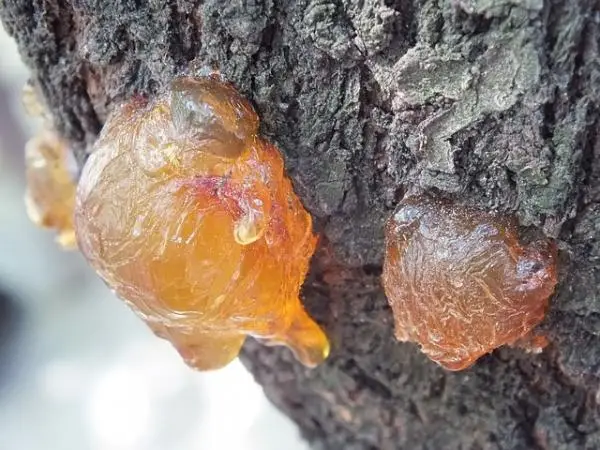Gummies is a fear-inspiring word for any gardener or tree gardener. It is one of the worst conditions that our trees can suffer but, fortunately, it is not always fatal and there are ways to combat and defeat it.
If you have already seen any symptoms in your woody plants such as shrubs and trees or just want to learn more about this disease, join us in this article in which we talk about what gummosis is, its treatment and how to avoid it .
What is gummosis – a symptom of tree problems
To begin with, it must be specified that, despite what has been said above, gum disease is not a disease in itself, but a symptom. It consists in that the tree produces gummy secretions of amber color , which can arise directly from the bark or from some wounds in it. This rubbery material is soft at first, but eventually dries and hardens with exposure to wind and weather. The gummosis prevents proper circulation of the sap , and will cause different parts of the plant to begin to dry out. In addition, trees affected by gummosis produce very small and undeveloped fruits, which end up falling prematurely.
Gum clumps are not always visible and it may be the case that a tree is secreting them below ground level, so in these cases we would only appreciate the rest of the symptoms: spoiled fruits and wilting of some parts.
It is a particularly problematic condition in fruit trees , which can cause great losses in plantations such as citrus.
Causes of gum disease in trees
There are many causes that can produce gummosis in a tree, since this is, after all, an emergency measure that the tree takes to protect itself, sacrificing some of its parts and nutrients. To take an easy-to-understand example, gummosis is for trees like fever for us: not a disease but a symptom of the fight against a disease or illness. Among the main causes are:
- One of the most common is root asphyxia due to overwatering . When a plant is watered too abundantly, or when the soil does not have good drainage, the water collects and prevents the roots from absorbing the oxygen that the plant needs. This is particularly dangerous in summer, which is when plants are most stressed and need the most oxygen.
- It can also be due to a fungal infection , either due to too much humidity or due to pruning with tools without disinfecting. For this type of thing it is vital to always disinfect our gardening tools before and after use.
- Finally, some borer insects can also be the cause of gum disease, as they injure the tree by burying themselves under its bark.

Gummies: treatment
If the tree already shows symptoms of gummosis, there are some measures you can take to try to cure it. Follow these tips for treating gummies on trees , depending on the source of the problem:
- Take a knife or similar tool, disinfect it, and carefully remove the area of dark sap that has become rubber or hardened. Then, apply healing paste to the affected area, and repeat this process every two weeks, until the tree stops producing gummy secretions and the symptoms stop.
- If the problem is a fungal attack, it will be necessary to apply a fungicide , in the same way as an insecticide or pesticide if the attack is from boring insects. In the latter case, you should be able to see the small holes once you remove the gummy substance.

How to avoid gummosis in plants
The best, without a doubt, is prevention rather than cure. Taking the appropriate measures will save us scares with our plants, and the possible loss of some of them. Also keep in mind that gummosis can also affect woody shrubs, not just trees. In any case, these are the measures to take into account to prevent gum disease :
- Don’t water more than necessary . Especially in summer, which is when it is easier for root asphyxia to occur. It is preferable that you water more often than that you flood the entire field once every X days.
- Ensures good drainage . If your soil takes more than 15 minutes to absorb water after watering, you have a drainage problem. Remove soil, add organic matter, or even provide soil of a suitable composition. Unfortunately, it is not a problem of easy or comfortable solution, but a soil with good drainage is necessary for a large number of plants.
- Always disinfect your tools . Pruning done with non-disinfecting tools can spread the problem to all the plants you work with later. Don’t save on disinfectant.
- Apply wound healing agent after pruning. This will prevent possible infections through an open wound.
- And finally, pay what is necessary , no more and no less. If you overdo it, the high amount of nitrogen in the soil could attract pests to your crop.
